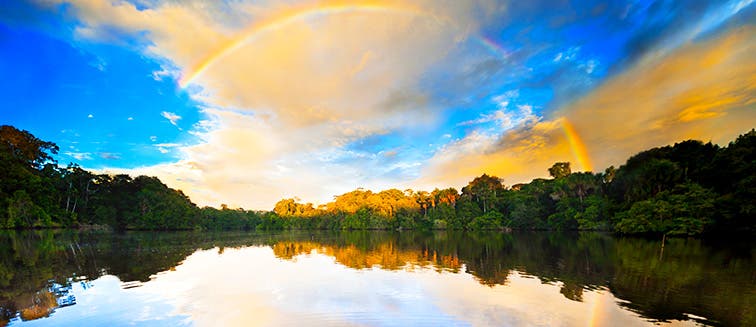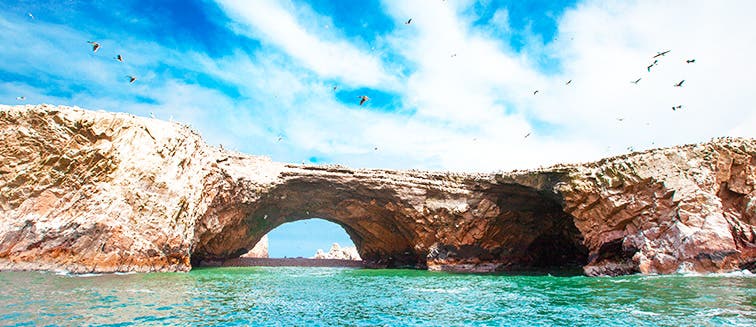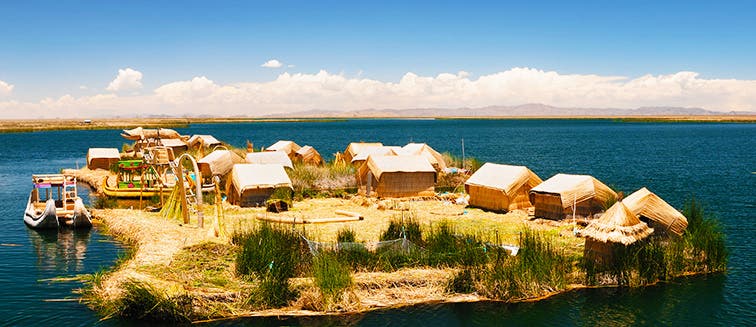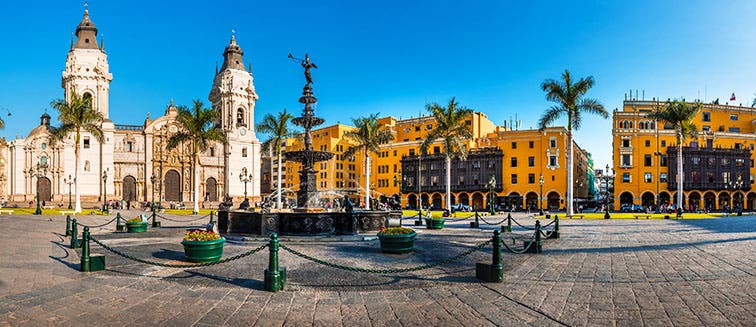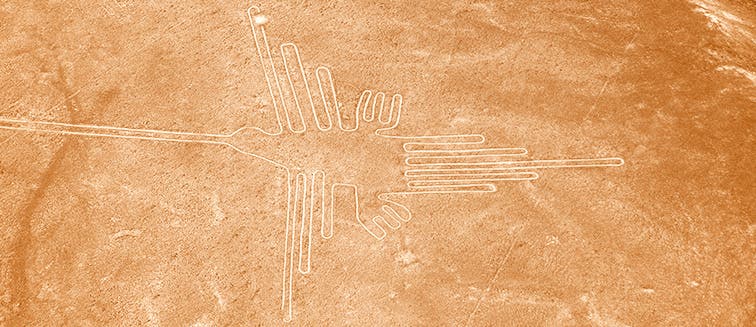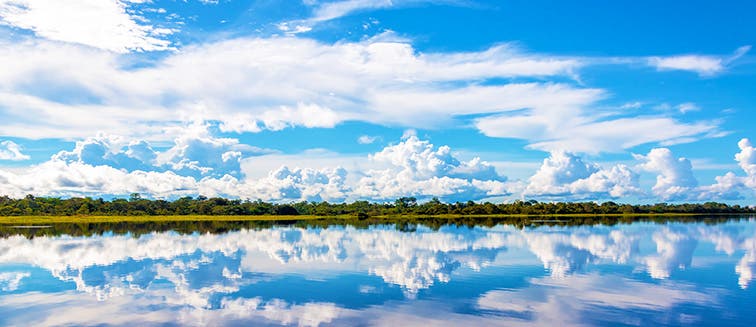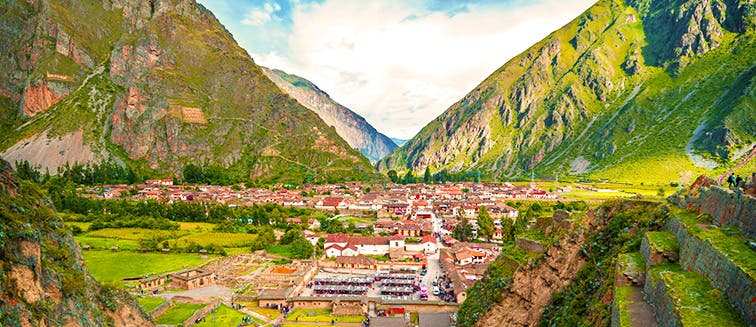Africa
Americas
Asia
Europe
Oceania
Travel Agent Support:
+61 02 8823 5094
Mon - Fri: 9 am - 15 hrs
Saturday & Sunday: Closed
What to see in Peru
Arequipa
Tourist attractions Arequipa
The birthplace of the Nobel Prize-winner, Mario Vargas Llosa, is the second largest city in Peru. If you decide to visit Arequipa, don't be surprised to find cities with such quintessentially Spanish names as Granada, Toledo and Seville. To learn a little about it before your visit, and to help you make plans and get the most out of your trip, we offer you this little guide.
Called the white city because of its buildings made of ashlar stone and because of its mixed race and Spanish presence, it is also known as the city of the Eternal Blue Sky because of its extraordinary climate with mild temperatures. Before starting this article, we recommend you read Peru travel tips and practical information or Vero's 20-day tour of Peru.
Visiting Arequipa to see the city from the Carmen Alto look-out point
About six km from the city centre is Carmen Alto, a small town that you can reach by bus. Its most attractive feature is the view, which includes the white houses of the city, but above all the green landscape that surrounds it, with the Misti volcano behind.
At the look-out point there's a small stall selling natural juices and a guinea pig, llama and alpaca farm. Start your visit here if you want to have a general overview of Arequipa or postpone the look-out point for a time when you need peace and quiet.
Yanahuara Look-out point
A little closer to the centre, some two km away, is the district of Yanahuara, where this look-out point, dating from the nineteenth century, is located. In the surroundings you will find the typical white buildings of Arequipa, built on ashlars.
Ashlars are large carved blocks of stone that cannot be manipulated by hand and constitute the city's typical construction method.
San Camilo: the most beautiful market in Peru
The title is not official, but many travellers enamoured with the country claim that the market of San Camilo is the most beautiful in Peru.
Designed by Gustave Eiffel, the iron structure of the market is notable for its bright colours, with long yellow columns crowned by the red roof. Inside you will find fruit stands, typical food of the country and plenty of vibrant activity.
It is not unusual to see the children of the stall owners doing their homework alongside their working parents. Or two acquaintances talking for hours as if they were in their living room at home.
Santa Catalina Convent
As in the rest of Peru, visiting Arequipa means a chance to see religious treasures, such as the Santa Catalina Convent. Don't let its name fool you. The convent is actually a small village of about 20,000 square meters painted in an ochre colour that contrasts with the clear blue sky. Long corridors and interior patios connect the various cells where the Peruvian noblewomen of yesteryear lived their lives dedicated to prayer... or other activities.
Nowadays, those ladies have been replaced by cloistered nuns who only emerge for a walk in the streets once the tourists have disappeared, every afternoon.
Arequipa Plaza de Armas
The Plaza de Armas vies with the San Camilo Market for the honour of being considered the heart of the city. Children run around its gardens, dominated by a huge fountain and surrounded by a two-storey arcade, while tourists rest on its benches. It seems strange to find such a quiet area in the centre of the city, and yet it is possible.
The fountain is crowned by the statue of the soldier Tuturu, who was in charge of raising the alarm if the city was in danger, and the arcades correspond to the portals that surround the square: the Portal del Regocijo or Portal de Flores, the Portal del Cabildo or Portal de la Municipalidad and the Portal de las Delicias or Portal de San Agustín.
Arequipa Cathedral
Located at one end of the Plaza de Armas, visiting Arequipa and not visiting the complex that the Cathedral forms with the Plaza de Armas would be unforgivable, given that it has been declared a World Heritage Site by UNESCO.
The original cathedral building was erected in the 16th century, but the seismic activity in the area has destroyed it several times. The exterior of the building is notable for its high tower, and inside you will see that the altars are made of Carrara marble.
Travelling to Arequipa and its surroundings
Arequipa is in the Andes mountains, surrounded by an incredible landscape dominated by two great volcanic peaks: the Misti and the Pichu volcanoes. Its snowy peaks can be seen from almost any point in the city, but you can also pay to go on excursions to them. The landscape is worth it.
OUR BEST TRIPS TO AREQUIPA
YOU ALSO LIKE
Tourist attractions peru
Points of interests
- Trips to Aguas Calientes
- Trips to Arequipa
- Trips to Colca Canyon
- Trips to Cusco
- Trips to Huacachina Oasis
- Trips to Iquitos
- Trips to Islas Ballestas
- Trips to Lake Titicaca
- Trips to Lima
- Trips to Machu Picchu
- Trips to Nazca
- Trips to Paracas
- Trips to Puerto Maldonado
- Trips to Sacred Valley
Other Points of interests
- Trips to Amazon
- Trips to Argentinian Patagonia
- Trips to Banos
- Trips to Baquerizo Moreno
- Trips to Bariloche
- Trips to Barrio de Boca
- Trips to Bogota
- Trips to Buenos Aires
- Trips to Buzios
- Trips to Cartagena de Indias
- Trips to Chilean Patagonia
- Trips to Christ the Redeemer
- Trips to Coffee Axis
- Trips to Comuna 13
- Trips to Copacabana Beach
- Trips to Cotopaxi National Park
- Trips to Cuenca
- Trips to Desierto de Atacama
- Trips to Easter Island
- Trips to Eduardo Avaroa
- Trips to El Calafate
- Trips to Galapagos Islands
- Trips to Getsemani
- Trips to Guayaquil
- Trips to Iguazu Falls
- Trips to Iguazu Falls
- Trips to Ilha Grande
- Trips to Isabela Island
- Trips to Islas del Rosario
- Trips to La Candelaria
- Trips to La Loberia Beach
- Trips to La Paz
- Trips to Lake Titicaca
- Trips to Luna Valley
- Trips to Manaus
- Trips to Medellín
- Trips to Mendoza
- Trips to Middle of the World Monument
- Trips to Mindo
- Trips to Otavalo
- Trips to Paraty
- Trips to Perito Moreno
- Trips to Potosi & Cerro Rico
- Trips to Praia do Forte
- Trips to Puerto Natales
- Trips to Quilotoa
- Trips to Quito
- Trips to Rapa Nui National Park
- Trips to Reserva Nacional Los Flamencos
- Trips to Rio de Janeiro
- Trips to Riobamba
- Trips to Ruins of Ingapirca
- Trips to Salar de Uyuni
- Trips to Salvador
- Trips to San Andrés
- Trips to San Cristobal Island
- Trips to San Felipe de Barajas Castle
- Trips to San Pedro de Atacama
- Trips to San Rafael Glacier
- Trips to San Telmo
- Trips to Santa Cruz Island
- Trips to Santa Lucía Hill
- Trips to Santa Marta
- Trips to Santiago de Chile
- Trips to São Paulo
- Trips to Serrano & Balmaceda Glaciers
- Trips to Sucre
- Trips to Tayrona
- Trips to The Devil's Nose
- Trips to Tiahuanaco Ruins
- Trips to Torres del Paine National Park
- Trips to Ushuaia
- Trips to Valley of the Moon
- Trips to Valparaiso
- Trips to Vicente Perez Rosales National Park
- Trips to Viña del Mar
Countries Nearby





